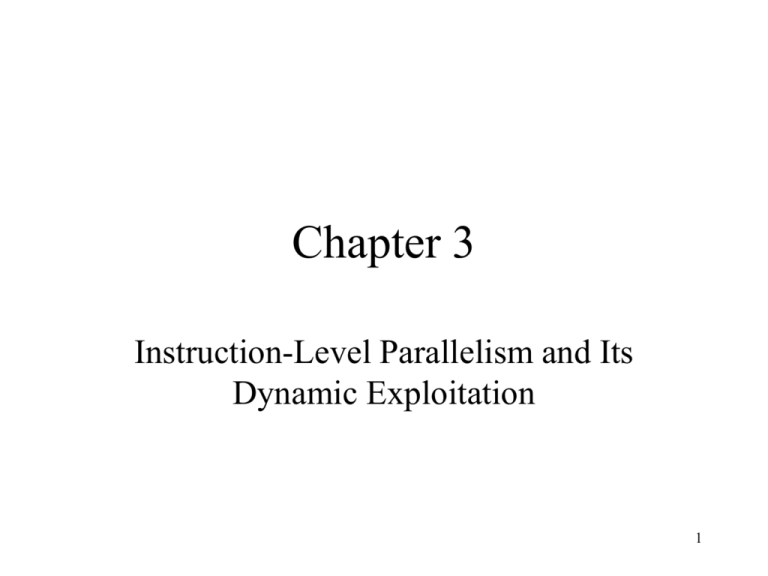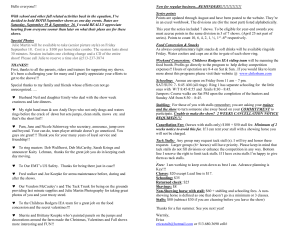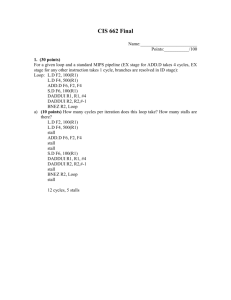Chapter 3 (and parts of Appendix A) Lecture
advertisement

Chapter 3 Instruction-Level Parallelism and Its Dynamic Exploitation 1 Overview • Instruction level parallelism • Dynamic Scheduling Techniques – Scoreboarding (Appendix A.8) – Tomasulo’s Algorithm • Reducing Branch Cost with Dynamic Hardware Prediction – Basic Branch Prediction and Branch-Prediction Buffers – Branch Target Buffers 2 CPI Equation Pipeline CPI = Ideal pipeline CPI + Structural stalls + RAW stalls + WAR stalls + WAW stalls + Control stalls Technique Reduces Loop unrolling Control stalls Basic pipeline scheduling RAW stalls Dynamic scheduling with scoreboarding RAW stalls Dynamic scheduling with register renaming WAR and WAW stalls Dynamic branch prediction Control stalls Issuing multiple instructions per cycle Ideal CPI Compiler dependence analysis Ideal CPI and data stalls Software pipelining and trace scheduling Ideal CPI and data stalls Speculation All data and control stalls Dynamic memory disambiguation RAW stalls involving memory 3 Instruction Level Parallelism • Potential overlap among instructions • Few possibilities in a basic block – Blocks are small (6-7 instructions) – Instructions are dependent • Exploit ILP across multiple basic blocks – Iterations of a loop for (i = 1000; i > 0; i=i-1) x[i] = x[i] + s; – Alternative to vector instructions 4 Basic Pipeline Scheduling • Find sequences of unrelated instructions • Compiler’s ability to schedule – Amount of ILP available in the program – Latencies of the functional units • Latency assumptions for the examples – Standard MIPS integer pipeline – No structural hazards (fully pipelined or duplicated units – Latencies of FP operations: Instruction producing result Instruction using result Latency FP ALU op FP ALU op 3 FP ALU op SD 2 LD FP ALU op 1 LD SD 0 5 Sample Pipeline EX IF ID FP1 FP2 FP3 FP4 FP1 FP2 FP3 FP4 DM WB ... FP ALU IF FP ALU FP ALU SD IF ID FP1 FP2 FP3 FP4 DM WB IF ID stall stall stall FP1 FP2 ID FP1 FP2 FP3 FP4 DM WB IF ID EX stall stall DM WB FP3 6 Basic Scheduling for (i = 1000; i > 0; i=i-1) x[i] = x[i] + s; Pipelined execution: Loop: LD F0, 0(R1) stall ADDD F4, F0, F2 stall stall SD 0(R1), F4 SUBI R1, R1, #8 stall BNEZ R1, Loop stall 1 2 3 4 5 6 7 8 9 10 Sequential MIPS Assembly Code Loop: LD ADDD SD SUBI BNEZ F0, 0(R1) F4, F0, F2 0(R1), F4 R1, R1, #8 R1, Loop Scheduled pipelined execution: Loop: LD F0, 0(R1) 1 SUBI R1, R1, #8 2 ADDD F4, F0, F2 3 stall 4 BNEZ R1, Loop 5 SD 8(R1), F4 6 7 Dynamic Scheduling • Scheduling separates dependent instructions – Static – performed by the compiler – Dynamic – performed by the hardware • Advantages of dynamic scheduling – Handles dependences unknown at compile time – Simplifies the compiler – Optimization is done at run time • Disadvantages – Can not eliminate true data dependences 8 Out-of-order execution (1/2) • Central idea of dynamic scheduling – In-order execution: DIVD F0, F2, F4 IF ID DIV ….. ADDD F10, F0, F8 IF ID stall stall stall … SUBD F12, F8, F14 IF stall stall ….. – Out-of-order execution: DIVD F0, F2, F4 SUBD F12, F8, F14 ADDD F10, F0, F8 IF ID DIV ….. IF ID A1 A2 A3 A4 … IF ID stall ….. 9 Out-of-Order Execution (2/2) • Separate issue process in ID: – Issue • decode instruction • check structural hazards • in-order execution – Read operands • Wait until no data hazards • Read operands • Out-of-order execution/completion – Exception handling problems – WAR hazards 10 DS with a Scoreboard • Details in Appendix A.8 • Allows out-of-order execution – Sufficient resources – No data dependencies • Responsible for issue, execution and hazards • Functional units with long delays – Duplicated – Fully pipelined • CDC 6600 – 16 functional units 11 MIPS with Scoreboard 12 Scoreboard Operation • Scoreboard centralizes hazard management – Every instruction goes through the scoreboard – Scoreboard determines when the instruction can read its operands and begin execution – Monitors changes in hardware and decides when an stalled instruction can execute – Controls when instructions can write results • New pipeline ID Issue EX Read Regs Execution WB Write 13 Execution Process • Issue – Functional unit is free (structural) – Active instructions do not have same Rd (WAW) • Read Operands – Checks availability of source operands – Resolves RAW hazards dynamically (out-of-order execution) • Execution – Functional unit begins execution when operands arrive – Notifies the scoreboard when it has completed execution • Write result – Scoreboard checks WAR hazards – Stalls the completing instruction if necessary 14 Scoreboard Data Structure • Instruction status – indicates pipeline stage • Functional unit status Busy – functional unit is busy or not Op – operation to perform in the unit (+, -, etc.) Fi – destination register Fj, Fk – source register numbers Qj, Qk – functional unit producing Fj, Fk Rj, Rk – flags indicating when Fj, Fk are ready • Register result status – FU that will write registers 15 Scoreboard Data Structure (1/3) Instruction LD F6, 34(R2) LD F2, 45(R3) MULTD F0, F2, F4 SUBD F8, F6, F2 DIVD F10, F0, F6 ADDD F6, F8, F2 Name Integer Mult1 Mult2 Add Divide Busy Y Y N Y Y Issue Y Y Y Y Y Read operands Execution completed Write Y Y Y Y Y Op Load Mult Fi F2 F0 Fj R3 F2 Fk Qj F4 Integer Sub Div F8 F10 F6 F0 F2 F6 Qk Integer Mult1 F0 F2 F4 F6 F8 F10 F12 Functional Unit Mult1 Int Add Div ... Rj N N Rk Y N N Y Y F30 16 Scoreboard Data Structure (2/3) 17 Scoreboard Data Structure (3/3) 18 Scoreboard Algorithm 19 Scoreboard Limitations • Amount of available ILP • Number of scoreboard entries – Limited to a basic block – Extended beyond a branch • Number and types of functional units – Structural hazards can increase with DS • Presence of anti- and output- dependences – Lead to WAR and WAW stalls 20 Tomasulo Approach • Another approach to eliminate stalls – Combines scoreboard with – Register renaming (to avoid WAR and WAW) • Designed for the IBM 360/91 – High FP performance for the whole 360 family – Four double precision FP registers – Long memory access and long FP delays • Can support overlapped execution of multiple iterations of a loop 21 Tomasulo Approach 22 Stages • Issue – Empty reservation station or buffer – Send operands to the reservation station – Use name of reservation station for operands • Execute – Execute operation if operands are available – Monitor CDB for availability of operands • Write result – When result is available, write it to the CDB 23 Example (1/2) 24 Example (2/2) 25 Tomasulo’s Algorithm An enhanced and detailed design in Fig. 3.5 of the textbook 26 Loop Iterations Loop: LD F0, 0(R1) MULTD F4,F0,F2 SD 0(R1), F4 SUBI R1, R1, #8 BNEZ R1, Loop 27 Dynamic Hardware Prediction • Importance of control dependences – Branches and jumps are frequent – Limiting factor as ILP increases (Amdahl’s law) • Schemes to attack control dependences – Static • Basic (stall the pipeline) • Predict-not-taken and predict-taken • Delayed branch and canceling branch – Dynamic predictors • Effectiveness of dynamic prediction schemes – Accuracy – Cost 28 Basic Branch Prediction Buffers a.k.a. Branch History Table (BHT) - Small direct-mapped cache of T/NT bits Branch Instruction IR: + Branch Target BHT T (predict taken) PC: NT (predict not- taken) PC + 4 29 N-bit Branch Prediction Buffers Use an n-bit saturating counter Only the loop exit causes a misprediction 2-bit predictor almost as good as any general n-bit predictor 30 Prediction Accuracy of a 4K-entry 2-bit Prediction Buffer 31 Correlating Branch Predictors a.k.a. Two-level Predictors – Use recent behavior of other (previous) branches Branch Instruction IR: + Branch Target BHT T (predict taken) PC: NT (predict not- taken) 1-bit global branch history: NT/T (stores behavior of previous branch) PC + 4 NT T 32 Example BNEZ DADDIU L1: DADDIU BNEZ L2: R1, L1 ; branch b1 (d!=0) R1, R0, #1 R3, R1, #-1 R3, L2 . . . ; branch b2 Basic one-bit predictor d=? b1 pred 2 0 2 0 NT T NT T b1 action new b1 pred b2 pred b2 action T NT T NT T NT T NT NT T NT T T NT T NT new b2 pred T NT T NT One-bit predictor with one-bit correlation d=? b1 pred 2 0 2 0 NT/NT T/NT T/NT T/NT b1 action new b1 pred b2 pred b2 action T NT T NT T/NT T/NT T/NT T/NT NT/NT NT/T NT/T NT/T T NT T NT new b2 pred NT/T NT/T NT/T NT/T 33 (2,2) Branch Prediction Buffer 34 (m, n) Predictors • Use behavior of the last m branches • 2m n-bit predictors for each branch • Simple implementation – Use m-bit shift register to record the behavior of the last m branches m-bit GBH (m,n) BPF PC: n-bit predictor 35 Size of the Buffers • Number of bits in a (m,n) predictor – 2m x n x Number of entries in the table • Example – assume 8K bits in the BHT – – – – (0,1): 8K entries (0,2): 4K entries (2,2): 1K entries (12,2): 1 entry! • Does not use the branch address • Relies only on the global branch history 36 Performance Comparison of 2-bit Predictors 37 Branch-Target Buffers • Further reduce control stalls (hopefully to 0) • Store the predicted address in the buffer • Access the buffer during IF 38 Prediction with BTF 39 Target Instruction Buffers • Store target instructions instead of addresses • Advantages – BTB access can take longer than time between IFs and BTB can be larger – Branch folding • Zero-cycle unconditional branches – Replace branch with target instruction 40 Performance Issues • Limitations of branch prediction schemes – Prediction accuracy (80% - 95%) • Type of program • Size of buffer – Penalty of misprediction • Fetch from both directions to reduce penalty – Memory system should: • Dual-ported • Have an interleaved cache • Fetch from one path and then from the other 41





